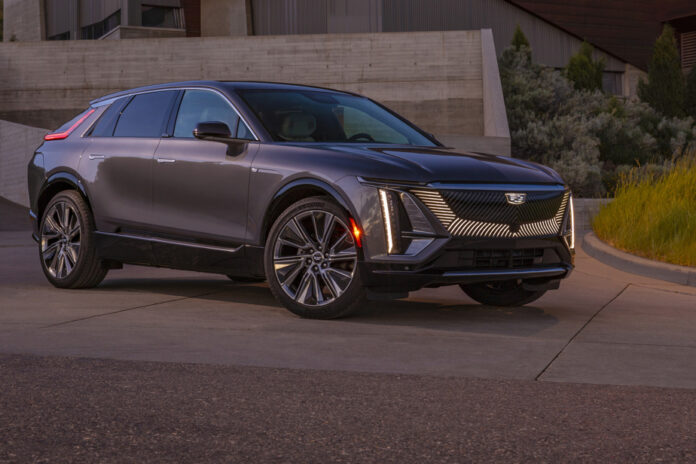The first contact with this Lyriq is spectacular, to say the least. The crossover, which is already in itself an object as imposing as it is streamlined with its 5 m long, gratifies us with a visual spectacle, a dance of diodes which are activated to highlight themselves. They are embedded in the grille and cascade over the ends of the front bumper. The rear is not left out either with these luminous boomerangs that embellish the pillars and then hug the tailgate. “L”s complete the transom, embossed in the fenders. You will have understood that this Lyriq is the result of a multitude of details which harmonize admirably well. The balance is there, thanks in part to the inherent distance between the bottom of the windshield and the center of the front axle, commonly referred to as the “dash to axle ratio”.
Taking advantage of a wheelbase of more than 3 m, this Lyriq offers a vast space with a beautiful glass opening on the outside world. It is accessed by means of handles nested in the doors which are in themselves large buttons triggering their opening. A curious technical choice that will be corrected for 2024. The dashboard supports a desire for lightening with a low construction free of materials that can reflect light. A large curved display is also visually cohesively integrated. Beyond this cohesion, it is the very solid aspect of the materials that shines through, and the obvious balance between the physical and digital keys. The storage is also where you want to find it, in addition to having a good capacity. Small disappointment: there is no front trunk.
This Lyriq is dressed in two different ways. A rear-wheel-drive version with 340 hp and 325 lb-ft is introduced, while a twin-engine version with 500 hp and 450 lb-ft increases traction. Both configurations are powered by a 102kWh battery compatible with a maximum charging power of 190kW. There’s little to complain about the performance of the rear-wheel-drive proposition tested. The power is satisfactory, although intentionally limited to undoubtedly ensure a more progressive and accessible character to this vehicle. The punch is more marked in recovery, an observation corroborated by the power gauge of the digital instrumentation. The autonomy is also very convincing at 502 km, a figure which was not really modified by driving on the motorway during the test.
This Lyriq requires a short period of adaptation. Its gear lever is placed on the steering column, an approach similar to that of Mercedes-Benz, but requires that you pull it towards you to engage the mode you want. The vehicle then sets off in an obvious silence barely disturbed by the silencing of its mechanics and a rather harmonious synthesized sound. Its damping, made up of non-adjustable shock absorbers and a five-arm configuration both front and rear, consistently absorbs cracked and cracked cobblestones without preaching excessive softness. On the other hand, this Lyriq is not infinitely sporty because of its direction defined by a somewhat lazy gear ratio and an excessively framed rear axle. Rather, it takes care of a surprising refinement that greatly isolates the cabin from outside noise.
Like any self-respecting latest-generation electric vehicle, this Lyriq relies heavily on technology to attract and even win over new customers. The approach is weighted, relying on a large horizontal touch screen which can also be pressed by a wheel placed on the cantilever console. Nearby, a textured cylinder provides sound volume control. The definition of the image is of very high quality and the black levels allow night driving that spares our eyes. To this multimedia system are added Google applications, including Google Maps which provides navigation. The design of the menus is very well done and a lower banner grouping shortcuts is constantly present despite the fact that CarPlay is on. The optional AKG audio system is also of high quality.
History has taught us that it is often in adversity that many great projects come to fruition. The Cadillac Lyriq reconfirms this observation with an exceptional performance for an all-newcomer. Endowed with an unusual aesthetic sensitivity for a vehicle retailing around $70,000, its rendering is extremely competitive both in terms of its autonomy and its refinement in motion. Admittedly, the proposal will not necessarily satisfy pure driving enthusiasts, who value a rather taciturn temperament, but that is not its raison d’être. Cadillac needed a complete vehicle targeting a fairly broad audience to break into the electric market and compete with established players. The Lyriq lays that out eloquently, which bodes well for a bright electric future for GM, so obviously production follows demand.
The Super Cruise system, offered on certain versions, remains a reference among semi-autonomous driving systems because of its constant interventions. This version allows, among other things, automated lane changing when the turn signal is activated.
In emergency braking, the adjustment of the Lyriq system makes braking at the threshold difficult to accomplish without the ABS system intervening quickly. One-pedal driving could also be a little smoother, despite the adjustable levels of intervention.
Despite its 500 hp and the use of the same 102 kWh battery as the rear-drive version, the all-wheel-drive version of the Lyriq sees its autonomy penalized by barely 8 km (494 km) in comparison.
The designers have chosen to integrate the button to open the glove box into the infotainment system. A questionable choice that requires starting the vehicle to access it.
This Lyriq can tow a trailer that can weigh up to 1587 kg (3500 lb). However, you have to opt for the two-motor version to obtain these capacities.















